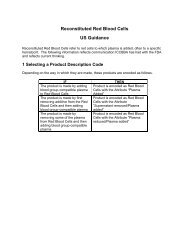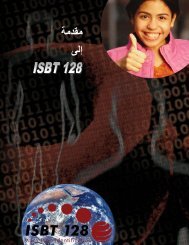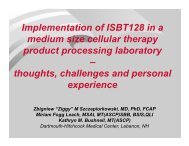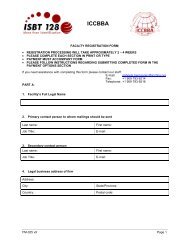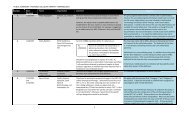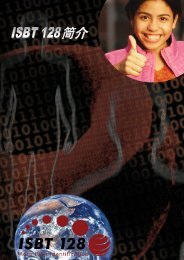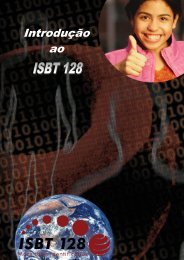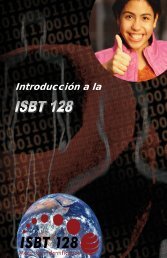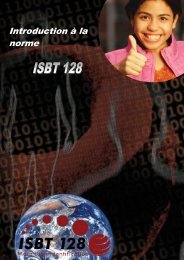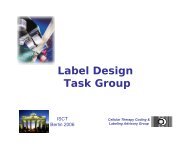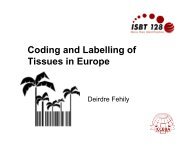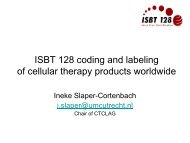ISBT 128 For Blood Components An Introduction 2nd ... - ICCBBA
ISBT 128 For Blood Components An Introduction 2nd ... - ICCBBA
ISBT 128 For Blood Components An Introduction 2nd ... - ICCBBA
You also want an ePaper? Increase the reach of your titles
YUMPU automatically turns print PDFs into web optimized ePapers that Google loves.
<strong>ISBT</strong> <strong>128</strong><br />
<strong>For</strong> <strong>Blood</strong> <strong>Components</strong><br />
<strong>An</strong> <strong>Introduction</strong><br />
3 rd Edition - 2014<br />
ISBN13: 978-1-933243-47-4<br />
ISBN: 1933243473<br />
IN-003<br />
Print Date: 04/2014
<strong>ISBT</strong> <strong>128</strong> for <strong>Blood</strong> <strong>Components</strong>, <strong>An</strong> <strong>Introduction</strong> – 3rd Edition 2<br />
John Armitage, Prof., BSc, PhD<br />
Paul Ashford, MSc. CEng. CSci.<br />
Wayne Bolton, B.App.Sc., M.App.Sc<br />
Editor<br />
Paul Ashford, MSc. CEng. CSci.<br />
Executive Director<br />
<strong>ICCBBA</strong><br />
Standards Committee<br />
Suzanne Butch, MA, MT(ASCP)SBB<br />
Pat Distler, MS, MT(ASCP)SBB<br />
Jørgen Georgsen, MD<br />
Suzy Grabowski, BA, BB(ASCP)SBB<br />
Mario Muon, MD<br />
Stefan Poniatowski, BSc, MIBMS<br />
Leigh Sims Poston, BS, MT(ASCP)<br />
Ineke Slaper-Cortenbach, PhD<br />
Zbigniew Szczepiorkowski, MD, PhD, FCAP<br />
Izabela Uhrynowska-Tyszkiewicz, MD, PhD<br />
Diane Wilson, BSN, MSN/MHA<br />
United Kingdom<br />
<strong>ICCBBA</strong><br />
Australia<br />
United States of America<br />
<strong>ICCBBA</strong><br />
Denmark<br />
United States of America<br />
Portugal<br />
Australia<br />
United States of America<br />
The Netherlands<br />
United States of America<br />
Poland<br />
United States of America<br />
Published by:<br />
<strong>ICCBBA</strong><br />
PO Box 11309, San Bernardino, CA 92423-1309 USA<br />
www.iccbba.org<br />
© 2014 <strong>ICCBBA</strong> All Rights Reserved www.iccbba.org
<strong>ISBT</strong> <strong>128</strong> for <strong>Blood</strong> <strong>Components</strong>, <strong>An</strong> <strong>Introduction</strong> – 3rd Edition 3<br />
Warranty<br />
<strong>ICCBBA</strong> provides no warranty that the use of <strong>ISBT</strong> <strong>128</strong> is suitable for<br />
any particular purpose and the selection, use, efficiency and suitability<br />
of <strong>ISBT</strong> <strong>128</strong> is the sole responsibility of the Licensed User.<br />
Liability<br />
<strong>ICCBBA</strong>'s liability is limited to that specified in the <strong>ICCBBA</strong> License<br />
Agreement which is available on the <strong>ICCBBA</strong> web site. Under no<br />
circumstances shall <strong>ICCBBA</strong>'s liability exceed the current annual<br />
license fee, and <strong>ICCBBA</strong> will in no circumstances be liable for any<br />
damages whatsoever, including without limitation damages for loss of<br />
data, business or goodwill or any other consequential losses of any<br />
nature arising from the use of <strong>ISBT</strong> <strong>128</strong>.<br />
<strong>ICCBBA</strong> manages the <strong>ISBT</strong> <strong>128</strong> Standard. <strong>ICCBBA</strong> is not an<br />
accrediting organization and is not responsible for adherence to the<br />
standard, the selection of product codes, or product labeling by<br />
facilities registered for its use.<br />
Copyright<br />
This document may be distributed freely provided that the copyright<br />
statement remains an integral part of the document or any quoted<br />
portion.<br />
It may also be translated, without written permission, provided that the<br />
translation indicates that it is a translation from an <strong>ICCBBA</strong><br />
copyrighted document and that <strong>ICCBBA</strong> is not responsible for the<br />
accuracy of the translation.<br />
Those wishing to implement <strong>ISBT</strong> <strong>128</strong> must register with <strong>ICCBBA</strong> and<br />
pay the annual license fee.<br />
© 2014 <strong>ICCBBA</strong> All Rights Reserved www.iccbba.org
<strong>ISBT</strong> <strong>128</strong> for <strong>Blood</strong> <strong>Components</strong>, <strong>An</strong> <strong>Introduction</strong> – 3rd Edition 4<br />
Table of Contents<br />
1 Preface ............................................................................................ 5<br />
2 What is the Information Environment ............................................ 6<br />
3 The <strong>ISBT</strong> <strong>128</strong> Standard ................................................................... 9<br />
4 Unique Donation Identification ...................................................... 10<br />
5 Product Descriptions ..................................................................... 11<br />
6 Other Data Structures ................................................................... 12<br />
7 Delivery Mechanisms .................................................................... 13<br />
8 Product Labeling............................................................................ 14<br />
9 Improving Safety at the Bedside ................................................... 16<br />
10 The Role of Technical Advisory Groups ........................................ 17<br />
11 The Role of <strong>ICCBBA</strong> ..................................................................... 18<br />
© 2014 <strong>ICCBBA</strong> All Rights Reserved www.iccbba.org
<strong>ISBT</strong> <strong>128</strong> for <strong>Blood</strong> <strong>Components</strong>, <strong>An</strong> <strong>Introduction</strong> – 3rd Edition 5<br />
1 Preface<br />
A great deal of important information is presented on the label of a blood<br />
product. The information varies from country to country according to<br />
licensing regulations, language differences and local practice but, in all<br />
cases, it is essential that it is recorded accurately, transferred correctly,<br />
and that critical items such as the blood groups, expiration date, and<br />
product description are clearly understood by medical personnel<br />
transfusing the product. In addition, robust audit trails must be in place to<br />
allow tracing between donor and recipient.<br />
In today’s world of multinational relief programs and military operations,<br />
blood products collected in one country may be used in another. There is<br />
a clearly identified need for ensuring the unique identification of the<br />
donation throughout the world and for international agreement on<br />
product descriptions. These fundamental requirements are essential for<br />
effective traceability on a global scale. <strong>An</strong> editorial in the Bulletin of the<br />
World Health Organization (WHO)<br />
(http://www.who.int/bulletin/volumes/91/5/12-116988/en/) recognized the<br />
need for effective traceability of all medical products of human origin<br />
(MPHO), including blood, organs, bone marrow, cord blood, corneas,<br />
tissues, reproductive cells and milk, to ensure recipient safety and called<br />
for the global adoption of <strong>ISBT</strong> <strong>128</strong> as the coding system for all MPHO.<br />
WHO and <strong>ICCBBA</strong> have a joint work program to take forward this<br />
initiative, and <strong>ICCBBA</strong> has been recognized as a nongovernmental<br />
organization in official relations with WHO.<br />
Increasingly, collection and transfusion facilities operate sophisticated<br />
computer systems to enhance safety and efficiency. Transfer of<br />
information between such facilities by electronic means ensures<br />
accuracy, but can only be effectively achieved in a global context by use<br />
of internationally agreed standards to define the information<br />
environment.<br />
© 2014 <strong>ICCBBA</strong> All Rights Reserved www.iccbba.org
<strong>ISBT</strong> <strong>128</strong> for <strong>Blood</strong> <strong>Components</strong>, <strong>An</strong> <strong>Introduction</strong> – 3rd Edition 6<br />
2 What is the Information Environment<br />
The information environment comprises a number of layers each of<br />
which needs to be in place to ensure that standardization can be<br />
achieved.<br />
Definitions<br />
At the base lies the dictionary of definitions that will ensure common<br />
understanding of terms. Without clarity at this level any further attempt at<br />
standardization is lost. However, obtaining agreement on definitions at<br />
the necessary level of detail involves careful analysis and robust<br />
consensus. A simple example serves to illustrate this. The term<br />
‘leukodepleted’ is widely understood as meaning the removal of<br />
leukocytes from a blood component; however there are different ways of<br />
carrying out such a removal, and differing amounts of residual leukocytes<br />
that are used to define leukodepleted. In order to accommodate these<br />
variations a range of definitions and associated values are required.<br />
Extreme care is needed in order to ensure that an internationally agreed<br />
dictionary is defined at the required level of granularity. This provides<br />
confidence in the consistency of both the information being transferred<br />
and the quality of the product described. The dictionary of definitions<br />
needs to be accessible to all users of the standard.<br />
© 2014 <strong>ICCBBA</strong> All Rights Reserved www.iccbba.org
<strong>ISBT</strong> <strong>128</strong> for <strong>Blood</strong> <strong>Components</strong>, <strong>An</strong> <strong>Introduction</strong> – 3rd Edition 7<br />
Reference Tables<br />
Once the definitions are in place, these can be combined to give the<br />
required items of information. Reference tables are built to map each<br />
item to a suitable code. Such tables can be large and complex and it is<br />
essential that they are managed to ensure that they can be modified to<br />
meet the changing needs of clinical practice in a manner that maintains<br />
their integrity and avoids ambiguity or redundancy.<br />
Product reference tables in particular need to combine a tightly defined<br />
structure with the flexibility to accommodate expansion and change in<br />
ways that cannot be anticipated.<br />
Successful management of definitions and reference tables requires<br />
input from both clinical experts in the field and information specialists.<br />
The tables themselves need to be published in a manner that allows all<br />
users of the standard to access the most up-to-date versions in a timely<br />
manner.<br />
Data Structures<br />
Having built reference tables which convert the clearly defined<br />
information into codes suitable for electronic transmission, it is necessary<br />
to define data structures in which to embed the data. Data structures<br />
define the technical characteristics necessary for the interpretation of the<br />
information. They specify the context and structure and provide the links<br />
to the appropriate reference tables for conversion of codes to meaningful<br />
information.<br />
Data structures need to be clear and unambiguous and must take into<br />
account any constraints imposed by the anticipated delivery<br />
mechanisms. <strong>For</strong> example, data structures that will be used in linear bar<br />
codes are limited in the number of characters they can contain.<br />
Delivery Mechanism<br />
The delivery mechanism is the means of delivering the electronic<br />
information. Probably the most well-known delivery mechanism is the<br />
linear bar code that has been used in blood transfusion practice for many<br />
years. There are in fact several types of linear bar codes including the<br />
© 2014 <strong>ICCBBA</strong> All Rights Reserved www.iccbba.org
<strong>ISBT</strong> <strong>128</strong> for <strong>Blood</strong> <strong>Components</strong>, <strong>An</strong> <strong>Introduction</strong> – 3rd Edition 8<br />
old fashioned Codabar system that was only capable of encoding<br />
numeric information, and Code <strong>128</strong>, a bar code standard widely used in<br />
coding standards such as GS1 and <strong>ISBT</strong> <strong>128</strong>.<br />
Higher capacity delivery systems are available using 2-dimensional or<br />
reduced space symbology bar codes. These codes can carry much more<br />
information in each symbol. More recently the use of radio frequency<br />
identification (RFID) chips that can carry encoded information is being<br />
developed for medical products of human origin.<br />
It is important to recognize that a range of delivery systems can sit at this<br />
level of the hierarchy. The definitions, reference tables, and data<br />
structures of the information standard can be delivered as easily in a<br />
linear bar code as they can in an RFID tag. The standards themselves<br />
need to be adaptable in order to make best use of new delivery<br />
mechanisms as they are developed.<br />
Labeling<br />
The final element in the coding system is the associated labeling.<br />
Although there will be other labeling requirements that fall outside the<br />
coding system, an effective coding system needs to consider the<br />
physical association between the information and the product. Whether<br />
incorporated into a bar code or an electronic tag, there needs to be a<br />
mechanism that will ensure correct physical assignment of information to<br />
the product, and confidence in the association between electronically<br />
stored information and eye-readable printed information. This latter<br />
requirement must not be overlooked in the enthusiasm to embrace<br />
remotely rewritable tags.<br />
The Information Environment<br />
Together these elements form the Information Environment. <strong>For</strong> such a<br />
system to be, and to remain, effective it must be carefully designed and<br />
managed. There must be an ongoing dialogue between clinical users,<br />
information specialists, and equipment and software vendors to ensure<br />
that the standard continues to support rapidly developing clinical<br />
practice.<br />
© 2014 <strong>ICCBBA</strong> All Rights Reserved www.iccbba.org
<strong>ISBT</strong> <strong>128</strong> for <strong>Blood</strong> <strong>Components</strong>, <strong>An</strong> <strong>Introduction</strong> – 3rd Edition 9<br />
3 The <strong>ISBT</strong> <strong>128</strong> Standard<br />
The <strong>ISBT</strong> <strong>128</strong> Standard provides the specification for many of the<br />
elements of the information environment required in transfusion and<br />
transplantation. It defines the lower three levels of the model, the<br />
definitions, reference tables, and data structures. Minimum requirements<br />
are also defined for delivery mechanisms and labeling. By complying<br />
with <strong>ISBT</strong> <strong>128</strong>, collection and processing facilities can provide<br />
electronically readable information that can be read by any other<br />
compliant system.<br />
<strong>ISBT</strong> <strong>128</strong> specifies:<br />
a donation numbering system that ensures globally unique<br />
identification;<br />
<br />
<br />
<br />
<br />
<br />
<br />
the information to be transferred, using internationally agreed<br />
reference tables;<br />
an international product reference database;<br />
the data structures in which this information is placed;<br />
a bar coding system for transfer of the information on the product<br />
label;<br />
a standard layout for the product label;<br />
a standard reference for use in electronic messaging.<br />
The standard, originally accepted by the <strong>ISBT</strong> Council in 1994, has<br />
gained widespread acceptance. It has been extended beyond blood<br />
transfusion to include cellular therapy, tissues, organs, and human milk<br />
products. By the end of 2013, more than 4,500 facilities in 77 countries<br />
across six continents were registered to use <strong>ISBT</strong> <strong>128</strong>, and this number<br />
continues to grow. More than 40 million blood, cell, and tissue products<br />
are labeled with <strong>ISBT</strong> <strong>128</strong> each year.<br />
© 2014 <strong>ICCBBA</strong> All Rights Reserved www.iccbba.org
01<br />
<strong>ISBT</strong> <strong>128</strong> for <strong>Blood</strong> <strong>Components</strong>, <strong>An</strong> <strong>Introduction</strong> – 3rd Edition 10<br />
4 Unique Donation Identification<br />
<strong>ISBT</strong> <strong>128</strong> provides for unique identification of any donation worldwide. It<br />
does this by using a 13 character identifier built up from three elements,<br />
the first identifying the collection facility, the second the year, and the<br />
third a sequence number for the donation. <strong>For</strong> example:<br />
G151715600001<br />
X<br />
where:<br />
G1517 identifies the collection facility (in this case Welsh <strong>Blood</strong> Service,<br />
Wales, United Kingdom);<br />
15 identifies the collection year as 2015;<br />
600001 is the serial number of the donation assigned by the collection<br />
facility.<br />
The two digits printed vertically are flag characters that allow individual<br />
bar codes in a number set to be discreetly identified providing an option<br />
to add process control.<br />
<strong>An</strong> additional character is enclosed in a box at the end of the identifier.<br />
This is a checksum character used when a number is entered into a<br />
computer system through the keyboard to verify the accuracy of the<br />
keyboard entry.<br />
Facility codes are assigned by <strong>ICCBBA</strong> who maintain a database of all<br />
registered facilities on their website (www.iccbba.org). A lookup program<br />
allows the look up of individual facility codes. <strong>ICCBBA</strong> licensed facilities<br />
and vendors are able to download a full listing of all registered facilities.<br />
© 2014 <strong>ICCBBA</strong> All Rights Reserved www.iccbba.org
<strong>ISBT</strong> <strong>128</strong> for <strong>Blood</strong> <strong>Components</strong>, <strong>An</strong> <strong>Introduction</strong> – 3rd Edition 11<br />
5 Product Descriptions<br />
<strong>ISBT</strong> <strong>128</strong> provides a comprehensive and highly flexible system for<br />
describing products and assigning product codes. The foundation of this<br />
system is a standard terminology which is constructed by international<br />
consensus to ensure global consistency in use and understanding. The<br />
standard terminology is maintained on the <strong>ICCBBA</strong> website and is<br />
publically available. <strong>Blood</strong> component terminology is managed by the<br />
blood transfusion Technical Advisory Groups of <strong>ICCBBA</strong>.<br />
New products are defined by combining pieces of information from the<br />
dictionary in a way that unambiguously describes the product. This<br />
process is made easier by the use of the concepts of component class,<br />
modifiers, core conditions, and attributes.<br />
This unique product description is assigned a product code that becomes<br />
incorporated into the <strong>ISBT</strong> <strong>128</strong> Product Description Codes Database<br />
table, ensuring that the product will be accurately identified in any<br />
country in the world that is using <strong>ISBT</strong> <strong>128</strong>.<br />
New entries into the dictionary can be readily accommodated allowing<br />
the system to expand to meet a growing range of products without losing<br />
the overall structure of the coding system.<br />
The following example is taken from the database table:<br />
Component Class:<br />
Modifier:<br />
Core Conditions:<br />
Attribute:<br />
Red <strong>Blood</strong> Cells<br />
None<br />
CPDA-1 (anticoagulant)<br />
450 mL (original volume)<br />
Refrigerated (storage condition)<br />
Irradiated<br />
has Product Description Code: E0206.<br />
While the description of a product in the Product Description Codes<br />
Database is standardized, the text that appears on the actual label of a<br />
product is under national control. This allows for differences in languages<br />
and regulatory requirements.<br />
© 2014 <strong>ICCBBA</strong> All Rights Reserved www.iccbba.org
<strong>ISBT</strong> <strong>128</strong> for <strong>Blood</strong> <strong>Components</strong>, <strong>An</strong> <strong>Introduction</strong> – 3rd Edition 12<br />
6 Other Data Structures<br />
In addition to the donation identifier and product codes, many other<br />
pieces of important information need to be provided with a blood<br />
donation. Through its wide range of data structures, <strong>ISBT</strong> <strong>128</strong> provides<br />
significant information including, but not limited to:<br />
<br />
<br />
<br />
<br />
<br />
<br />
<br />
<br />
<br />
<br />
ABO and Rh(D) <strong>Blood</strong> Groups;<br />
Type of Donation (Volunteer, Directed, Autologous, etc);<br />
Expiration Date and Time;<br />
Collection Date and Time;<br />
Red Cell Phenotyping Information;<br />
HLA Typing Information;<br />
CMV and other test results;<br />
Collection Container Catalog and Lot Number;<br />
Patient Date of Birth;<br />
Patient Identification Number.<br />
© 2014 <strong>ICCBBA</strong> All Rights Reserved www.iccbba.org
<strong>ISBT</strong> <strong>128</strong> for <strong>Blood</strong> <strong>Components</strong>, <strong>An</strong> <strong>Introduction</strong> – 3rd Edition 13<br />
7 Delivery Mechanisms<br />
The delivery mechanism is the means by which the information is<br />
represented in a machine-readable manner. The most common such<br />
mechanism is the linear bar code. <strong>ISBT</strong> <strong>128</strong> has traditionally been based<br />
on the linear bar code using Code <strong>128</strong> symbology and this is still<br />
required on blood donations. However, an additional two dimensional<br />
Data Matrix code may be added to a blood component label.<br />
A single Data Matrix code can carry the same information as encoded in<br />
multiple linear codes. This allows much more rapid scanning of units at<br />
the point of blood center issue and receipt into the transfusion laboratory.<br />
In the cellular therapy and tissue banking fields, the need to use very<br />
small containers means that label size is severely restricted and in these<br />
situations a use of Data Matrix code may replace linear codes.<br />
Comparative size of Code <strong>128</strong> and Data Matrix Symbols<br />
The Data Matrix symbol on the left contains all of the information held in<br />
the five Code <strong>128</strong> symbols on the right.<br />
There is much interest in the use of RFID tags. This technology is still<br />
developing, but may provide significant benefits in some situations. <strong>ISBT</strong><br />
<strong>128</strong> Compound Messages are compatible with RFID.<br />
© 2014 <strong>ICCBBA</strong> All Rights Reserved www.iccbba.org
<strong>ISBT</strong> <strong>128</strong> for <strong>Blood</strong> <strong>Components</strong>, <strong>An</strong> <strong>Introduction</strong> – 3rd Edition 14<br />
8 Product Labeling<br />
In addition to specifying the requirements for the electronic coding of<br />
information, <strong>ISBT</strong> <strong>128</strong> provides a standard labeling format that ensures a<br />
consistent layout of the bar codes on product labels. Critical eyereadable<br />
information such as blood groups, product description, and<br />
expiration date also appear in fixed positions on the label. This reduces<br />
the risk of confusion when products from multiple sources are being<br />
used.<br />
The <strong>ISBT</strong> <strong>128</strong>-specified label is illustrated below.<br />
1 2<br />
3<br />
4<br />
5<br />
6<br />
1 Donation Identification Number<br />
2 ABO/Rh <strong>Blood</strong> Groups<br />
3 Collection Date (optional)<br />
4 Product Code<br />
5 Expiration Date (and Time)<br />
6 Special Testing (optional)<br />
© 2014 <strong>ICCBBA</strong> All Rights Reserved www.iccbba.org
<strong>ISBT</strong> <strong>128</strong> for <strong>Blood</strong> <strong>Components</strong>, <strong>An</strong> <strong>Introduction</strong> – 3rd Edition 15<br />
In addition to linear bar codes, a 2-D bar code, comprising all the<br />
information in the linear bar codes, may be placed on the label. Scanning<br />
a single code improves efficiency, but requires an imaging scanner.<br />
© 2014 <strong>ICCBBA</strong> All Rights Reserved www.iccbba.org
<strong>ISBT</strong> <strong>128</strong> for <strong>Blood</strong> <strong>Components</strong>, <strong>An</strong> <strong>Introduction</strong> – 3rd Edition 16<br />
9 Improving Safety at the Bedside<br />
The risk of error due to misidentification at the bedside is recognized as<br />
one of the prime causes of incorrect transfusion. In order to support<br />
improved safety at this critical point, <strong>ISBT</strong> <strong>128</strong> data structures have been<br />
developed to hold patient critical information including date of birth and<br />
hospital number. <strong>An</strong> important characteristic of these data structures is<br />
the use of a ‘location code’ which allows the reading system to identify<br />
the item from which a code was read; hence it is possible to<br />
electronically distinguish between a patient identifier scanned from a<br />
wrist band or from a cross match label. This permits a high degree of<br />
control over the verification process. More information on the use of <strong>ISBT</strong><br />
<strong>128</strong> at the bedside may be found in Technical Bulletin 8: Specification for<br />
<strong>ISBT</strong> <strong>128</strong> Data Structures to Support the Secure Bedside Matching of<br />
Patient and Transfusion/Transplant Product Identification, which may be<br />
found on the <strong>ICCBBA</strong> website (www.iccbba.org).<br />
© 2014 <strong>ICCBBA</strong> All Rights Reserved www.iccbba.org
<strong>ISBT</strong> <strong>128</strong> for <strong>Blood</strong> <strong>Components</strong>, <strong>An</strong> <strong>Introduction</strong> – 3rd Edition 17<br />
10 The Role of Technical Advisory Groups<br />
<strong>ICCBBA</strong> involves international experts in blood, cellular therapy, tissue,<br />
and milk banking in the development and maintenance of the standard.<br />
These experts are organized into Technical Advisory Groups (TAGs) that<br />
meet regularly (both face-to-face and through conference calls) to further<br />
develop and expand the standard ensuring it continues to meet the<br />
needs of its users. The vital role of these groups cannot be<br />
overemphasized. It is only through the involvement of such expert panels<br />
that <strong>ICCBBA</strong> can be assured it has the knowledge base to anticipate the<br />
needs of its users in fields where change is constant. More than 300<br />
experts participate in the <strong>ICCBBA</strong> TAGs.<br />
<strong>For</strong> <strong>Blood</strong> Banking, the advisory groups are the Asia Pacific Technical<br />
Advisory Group (APTAG), the Europe, Middle East, and Africa Technical<br />
Advisory Group (EMATAG), and the Americas Technical Advisory Group<br />
(ATAG). The groups comprise participants from blood collection facilities,<br />
testing laboratories, transfusion services, professional organizations,<br />
regulatory agencies, and vendors from around the world.<br />
© 2014 <strong>ICCBBA</strong> All Rights Reserved www.iccbba.org
<strong>ISBT</strong> <strong>128</strong> for <strong>Blood</strong> <strong>Components</strong>, <strong>An</strong> <strong>Introduction</strong> – 3rd Edition 18<br />
11 The Role of <strong>ICCBBA</strong><br />
<strong>ICCBBA</strong> is the not-for-profit standards body responsible for the<br />
management, development, and distribution of the <strong>ISBT</strong> <strong>128</strong> Standard<br />
and is a nongovernmental organization in official relations with the World<br />
Health Organization. It maintains a permanent office to manage the<br />
registration of facilities, update reference tables and databases, and<br />
develop additional functionality. It supports Technical Advisory Groups<br />
that include experts from both the transfusion/transplantation community<br />
and relevant manufacturers.<br />
Fees collected by <strong>ICCBBA</strong> from registered facilities are used to support<br />
these functions.<br />
Through its activities <strong>ICCBBA</strong> provides the management support<br />
essential to sustain standard coding in the complex blood banking<br />
environment. In particular it delivers:<br />
1) stability – users can be confident in the stability of the standard<br />
to satisfy the long time periods over which information has to be<br />
retained;<br />
2) user focus – the user community are the experts in their field and<br />
<strong>ICCBBA</strong>, through its Technical Advisory Groups, ensures that<br />
the information standard meets, rather than dictates, user needs;<br />
3) flexibility – as clinical and scientific knowledge grows there is<br />
rapid development with changing information needs. <strong>ICCBBA</strong><br />
ensures that the standard is flexible enough to accommodate<br />
those needs;<br />
4) responsiveness – in these rapidly developing medical fields<br />
<strong>ICCBBA</strong> ensures that the standard is able to respond to user<br />
needs in a timely manner;<br />
5) globalization – <strong>ISBT</strong> <strong>128</strong> is a truly international standard with<br />
endorsement worldwide;<br />
6) compatibility – standards do not work in isolation but need to<br />
interface with equipment, software, and other standards.<br />
<strong>ICCBBA</strong> works with industry and other standards bodies to<br />
maximize compatibility.<br />
© 2014 <strong>ICCBBA</strong> All Rights Reserved www.iccbba.org
<strong>ISBT</strong> <strong>128</strong> for <strong>Blood</strong> <strong>Components</strong>, <strong>An</strong> <strong>Introduction</strong> – 3rd Edition 19<br />
<strong>Blood</strong>, cellular therapy, tissue, organ, and banked human milk collection<br />
facilities, and manufacturers of equipment or software that uses <strong>ISBT</strong><br />
<strong>128</strong>, are required to register with <strong>ICCBBA</strong> and pay a registration and an<br />
annual licensing fee. Registered organizations obtain access to all<br />
<strong>ICCBBA</strong> documents and databases.<br />
<strong>For</strong> further information on <strong>ISBT</strong> <strong>128</strong>, visit the <strong>ICCBBA</strong> website at<br />
www.iccbba.org.<br />
© 2014 <strong>ICCBBA</strong> All Rights Reserved www.iccbba.org



